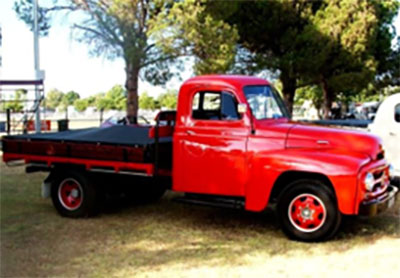Life on the West Island - Fruit and veg

26 July 2022
This week, the price of lettuces hit $12 at our local West Island supermarket. Some fast-food chains have resorted to putting cabbage on their hamburgers as lettuces are being priced out of the market. In fact, lettuce prices, driven by floods, “supply chain issues,” the war in Ukraine (!) and general shortages of fresh produce, have become a topic of national interest. Perhaps they are also symbolic of the rapid rises in inflation and interest rates which are putting household budgets under pressure.
But the sudden focus on the prices and availability of fresh fruit and vegetables got me thinking about earlier times on the West Island. When I was almost six, my parents purchased a closed-down shop in our small country town and christened it The Snack Bar. At first, this was really a misnomer because the reborn shop mainly revolved around selling fresh fruit and veg.
We were a fairly typical small-town family of Mum, Dad and three kids from humble backgrounds. In our town, most families did not possess luxury goods such as motor cars, refrigerators, washing machines or electric ovens.
For many years, we did not own a car, but we did have a truck. We felt very privileged to own our red International AR130 truck, which my father bought as a chassis-and-cowl vehicle, then had a tray and body built to his specifications. As was the style in those years, the side and tail boards had unique hand-painted decorations in yellow and white, of which were intensely proud. The Snack Bar name was painted on the driver’s door, while underneath in smaller print was the full name and address of the owner, as required by law at that time. The truck was built by American industrial giant International Harvester, which had also manufactured highly reliable tractors and heavy equipment since 1902. Under its rebranded name of Navistar, the company still produces heavy vehicles in America.
Anyway, the truck was essential for the fruit and veg business, which began in a small way but soon flourished. Three mornings a week, my father would rise at 3 am and drive off to the Adelaide East End Market some 90km away, arriving there around 4.30 am. In school holidays, one or more of us three kids would be allowed to go along – in fact, we all learned to drive in our beloved truck under Dad’s strict rule – you can learn to drive as soon as your feet can reach the pedals (around 11 years old for each of us). There wasn’t too much danger from approaching traffic at that time of the morning – in fact, it was rare to meet any vehicles at all for the first 80km of the trip, after which we would be on the outskirts of the city and would have to stop and hand over the controls to Dad.
To us, the East End Market was a wonderland. It was really a series of sprawling empty sheds for most of the time. But by the time we arrived, it would be filling with dozens of growers’ trucks from all over the state, loaded with every imaginable type of fruit and vegetables, mostly packed in reusable wooden crates but in some cases (such as cauliflowers), stacked in wondrous green pyramids held together by their untrimmed tops. Have you ever seen 1,000 bunches of crisp fresh carrots in a single pile on the back of a grower’s truck – probably picked and washed only hours before? Or a huge truck stacked high with 80kg sacks of freshly harvested potatoes? As kids, we were amazed by these sights, along with those of voluminous coolrooms of crunchy greens and the “warmrooms” packed with crates of bananas or pineapples from Queensland.
Many of the growers would give a few samples for kids to consume for early breakfast. We were particularly fond of the State Premier, who toward Christmas would drive his heavily laden truck from his Adelaide Hills orchard and place a few cases of plump juicy cherries on the ground for kids (and their fathers) to sample.
The market had a few curious rules. For instance, retailers were free to inspect and pay for their chosen produce at any time after 2 am. Growers would mark their crates in chalk for later pickup. But buyers were strictly prohibited from taking possession of their goods until 6.45 am. At that time, a siren would sound and there would be a scramble up a wooden staircase to the suspended mezzanine platform where the transport carts were stored. Ours was a modern model with pneumatic tyres, but most were two-metre long slatted wooden platforms with long handles and metal wheels. They were heavy, cumbersome and poorly balanced. Goods had to be loaded first at the front near the handles and legs, otherwise the cart would tip up, spilling fruit and veg across the asphalt floors.
Each cart could carry around 20 full crates at a time, so trucks could be filled quite quickly, tarpaulins fastened to cover the load and then it was off to the shop to start selling. We often had a few other calls to make to pick up manufactured goods, confectionery and general supplies, so the market truck only arrived back at our shop around lunchtime.
Customers would often gather on market days to pick up the freshest fruit and veg, knowing that our shop prided itself on only selling high quality produce at reasonable prices. Since many had no refrigeration at home, housewives of the day would often take their baskets “down the street” to the butcher, baker and The Snack Bar almost every day.
Now, on the West Island we stroll into the supermarket any time of day or night and mostly find plentiful stocks of not-so-fresh fruit and veg, delivered in bulk by huge semitrailers. But right now, there are few lettuces, even at $12 each!